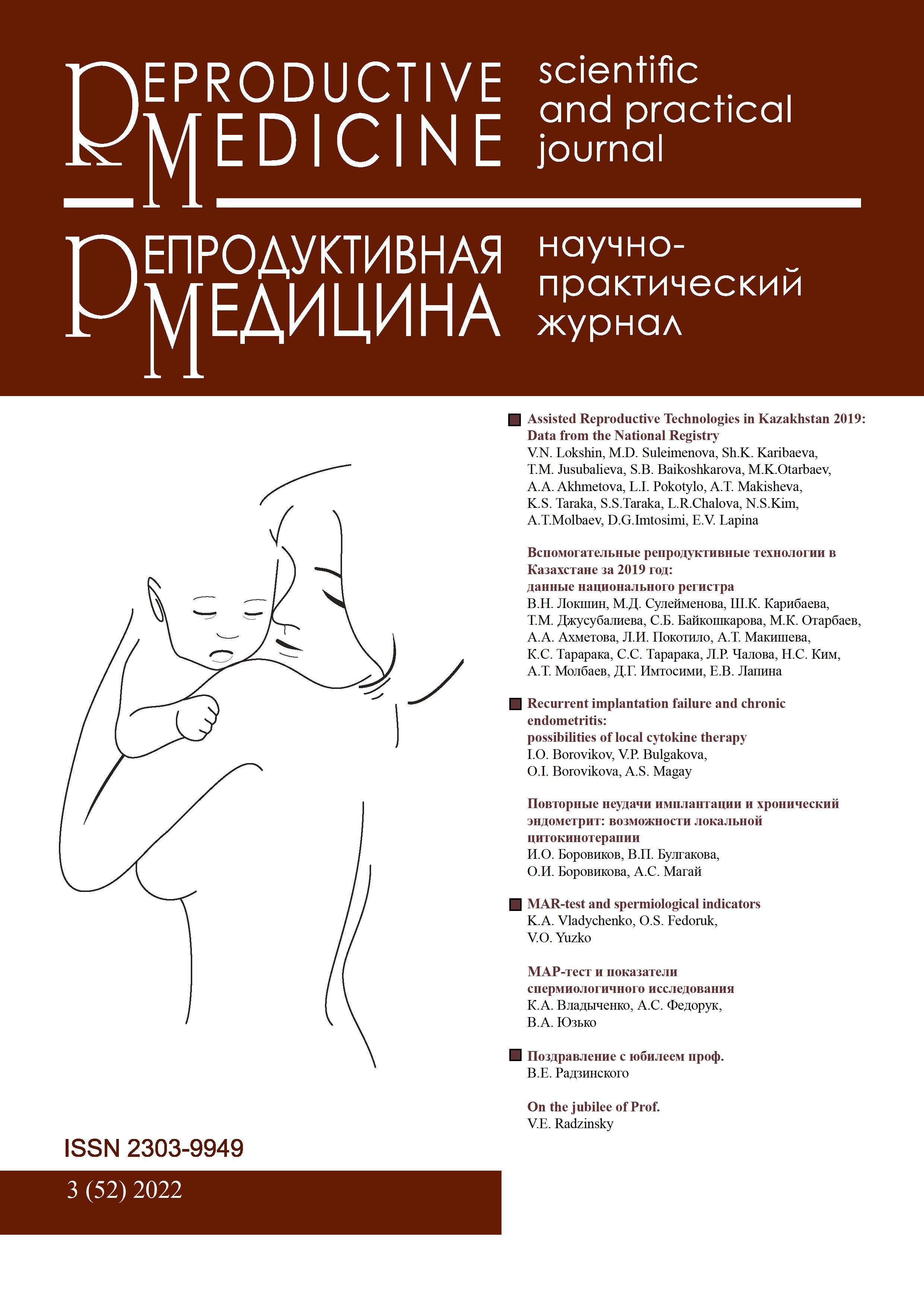Investigation of the relationship between the ovarian reserve indicators and the influence of lifestyle factors in primary infertility
DOI:
https://doi.org/10.37800/RM.3.2022.34-40Keywords:
infertility, ovarian reserve, anti-Mullerian hormone (AMH), FSH, infertility factorsAbstract
Relevance: Infertility in women is an urgent problem of modern health care. According to WHO experts for 2020, about 186 million people in the world suffer from infertility.
The purpose of the study was to study the indicators of ovarian reserve in women suffering from primary infertility and to validate a questionnaire to study the role of lifestyle factors in the genesis of infertility.
Methods: A cross-sectional study was conducted with the participation of 285 women, including 76 with primary infertility, 80 controls (healthy). An ultrasound study of the ovarian reserve, levels of AMH and FSH was performed. A questionnaire was developed and validation stages were carried out to determine the influence of risk factors on the development of infertility.
Results: A cross-sectional study was conducted in women aged 21-35 years with primary infertility. In the follicular phase, the levels of AMH (4.3±3.2) and FSH (9.00±6.66) remained within the normal range, however, morphological and functional
indicators of the weakening of the ovarian reserve were noted: the number of antral follicles sharply decreased (to 6.2± 2.2), the
volume of the right (9.8±5.0) and left (7.8±3.6) ovaries. At the first stage of the questionnaire validation to study the influence of lifestyle factors, it was found that the prevailing factor is the level of a woman's education and her physical fitness. 76.7% of women with primary infertility have higher education, 23.3% - secondary education. 47% of women with primary infertility
do not have sports in their lives, only 28% of women regularly go in for sports. Employability and early sexual experience also contribute to the problem of conception.
Conclusion: In the study, hormonal markers in both groups tended to decrease, while remaining within the acceptable range. The CAF index gave a very low reserve index, as did the volume of the right and left ovaries. The results of the first
stage of validation show that the main possible factors of infertility among women are the level of education and the physical condition of the female body, i.e. the level of involvement in sports. Further validation steps will be carried out to identify the correlation dependence.
References
Borght М.V., Wyns С. Fertility and infertility: Definition and epidemiology // Clin. Biochem. – 2018. – Vol. 62. – P. 2-10. https://doi.org/10.1016/j.clinbiochem.2018.03.012
Bongaarts J. Global fertility and population trends // Semin. Reprod. Med. – 2015. – Vol. 33(1). – P. 5-10. https://doi.org/10.1055/s-0034-1395272
Shapiro B.S., Daneshmand S.T., Desai J., Garner F.C., Aguirre M., Hudson C. The risk of embryo-endometrium asynchrony increases with maternal age after ovarian stimulation and IVF // RBMO. – 2016. – Vol. 33 (1). – P. 50-55. https://doi.org/10.1016/j.rbmo.2016.04.008.
Архангельский В.Н, Шульгин С.Г., Зинькина Ю.В. Репродуктивное поведение российских женщин в зависимости от образовательного статуса // РУДН. – 2020. – Т. 20, № 3. – C. 546-559 [Arxangel'skij V.N, Shul'gin S.G., Zin'kina Yu.V. Reproduktivnoe povedenie rossijskix zhenshhin v zavisimosti ot obrazovatel'nogo statusa // RUDN. – 2020. – T. 20, № 3. – C. 546-559 (in Russ.)]. https://doi.org/10.22363/2313-2272-2020-20-3-546-559.
Schwartz K.M, Martin C.E., Hipp H.S., Kawwass J.F. Pregnancy and Fertility Concerns: A Survey of United States Obstetrics and Gynecology Residents // Matern. Child. Health. J. – 2021. – Vol. 25(1). – P. 172-179. https://doi.org/10.1007/s10995-020-03027-w.
Pedro J., Brandão T., Schmidt L., Costa M.E, Martins M.V, What do people know about fertility? A systematic review on fertility awareness and its associated factors // Ups. J. Med. Sci. – 2018. – Vol. 123(2). – P. 71-81. https://doi.org/10.1080/03009734.2018.1480186.
Eskew A.M., Bedrick B.S., Chavarro J.E., Riley J.K., Jungheim E.S. Dietary patterns are associated with improved ovarian reserve in overweight and obese women: a cross-sectional study of the Lifestyle and Ovarian Reserve (LORe) cohort // Reprod. Biol. Endocrinol. – 2022. – Vol. 20. – Art. No. 33. https://doi.org/10.1186/s12958-022-00907-4.
Laqqan M.M., Yassin M.M. Predictive factors of ovarian response to GnRH antagonist stimulation protocol: AMH and age are potential candidates // Middle East Fertil. Soc. J. – 2021. – Vol. 26. – Art. No. 16. https://doi.org/10.1186/s43043-021-00062-7.
Downloads
Published
How to Cite
Issue
Section
License
The articles published in this Journal are licensed under the CC BY-NC-ND 4.0 (Creative Commons Attribution – Non-Commercial – No Derivatives 4.0 International) license, which provides for their non-commercial use only. Under this license, users have the right to copy and distribute the material in copyright but are not permitted to modify or use it for commercial purposes. Full details on the licensing are available at https://creativecommons.org/licenses/by-nc-nd/4.0/.




